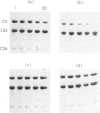Abstract
EDTA plasma from patients with hereditary angioedema (HAE), the genetic deficiency of C1-inhibitor, when incubated at 37 degrees produces a kinin-like activity which can induce contraction of oestrus rat uterus. The second component of complement (C2) has previously been suggested to be the source of this kinin-like activity, with the implication that C2-kinin is a normal product of complement activation. Our results show that purified human C2 is cleaved rapidly to C2a and C2b when added to HAE plasma, but not normal plasma or plasma from a danazol-treated HAE patient. However, the addition to HAE plasma of C2 at 20 X normal plasma concentration had no effect on the kinin activity generated on incubation at 37 degrees. In the presence of soya bean trypsin inhibitor, the rate of C2 cleavage and products were unaltered but no kinin activity was generated. C2 was cleaved by purified C1s to C2a and C2b. Incubation of C2 with trypsin resulted in cleavage to C2a and C2b followed by more extensive cleavage of both C2a and C2b. Kallikrein cleaved C2 to C2a and C2b but plasmin had no effect on C2. In no case was kinin activity generated. When C2 was cleaved by C1s to C2a and C2b then incubated with trypsin, kallikrein, or plasmin, no kinin activity was generated: only trypsin cleaved the C2 fragments further. The results suggest that C2 is not the source of the kinin-like activity generated in hereditary angioedema plasma.
Full text
PDF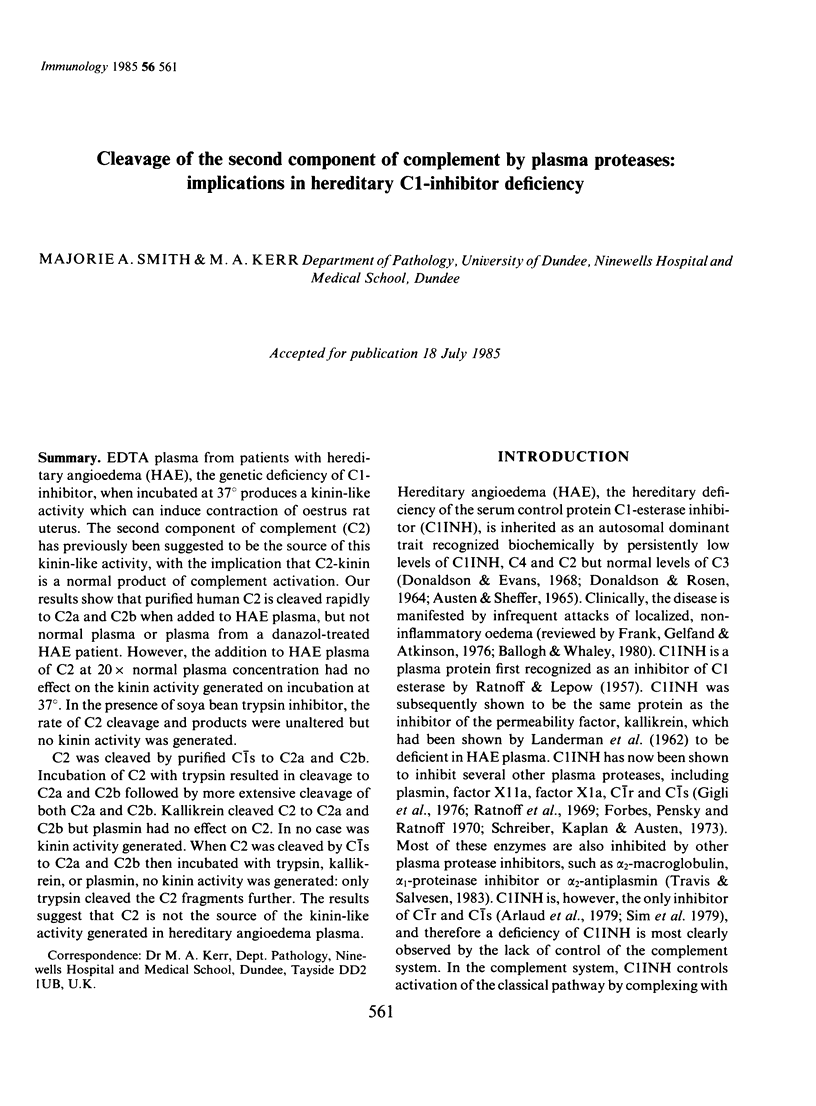
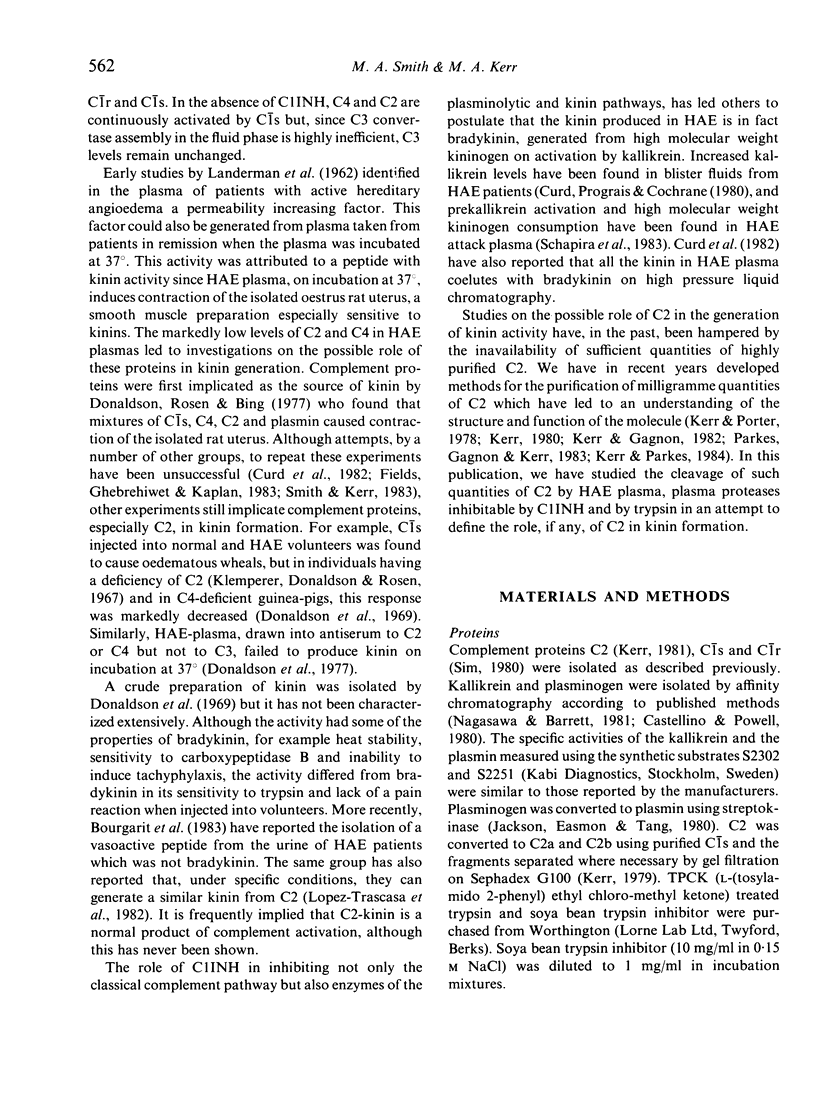


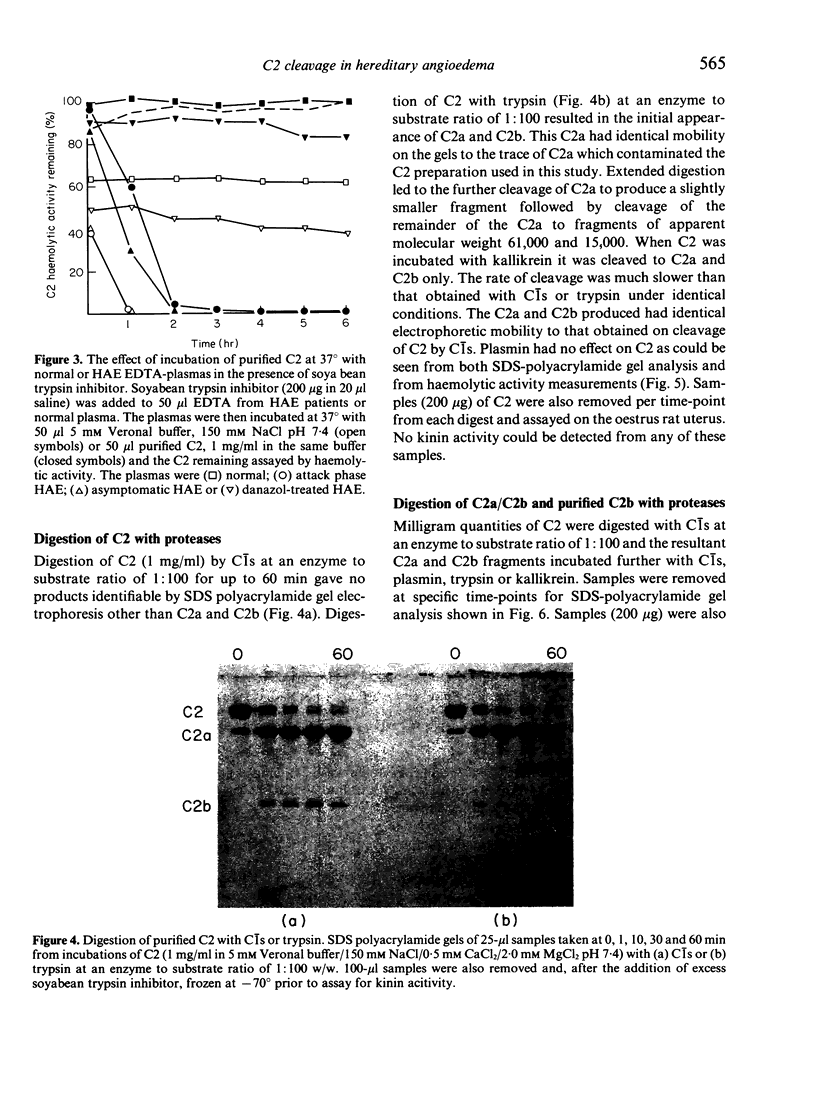
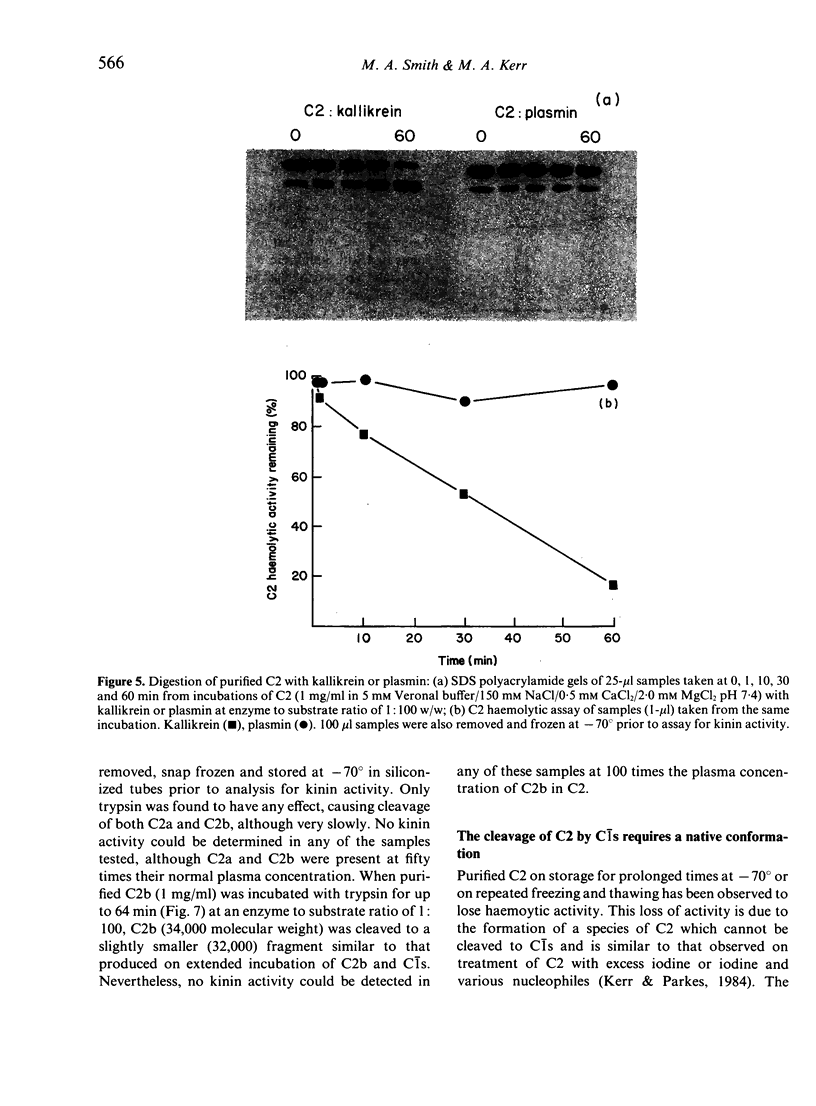
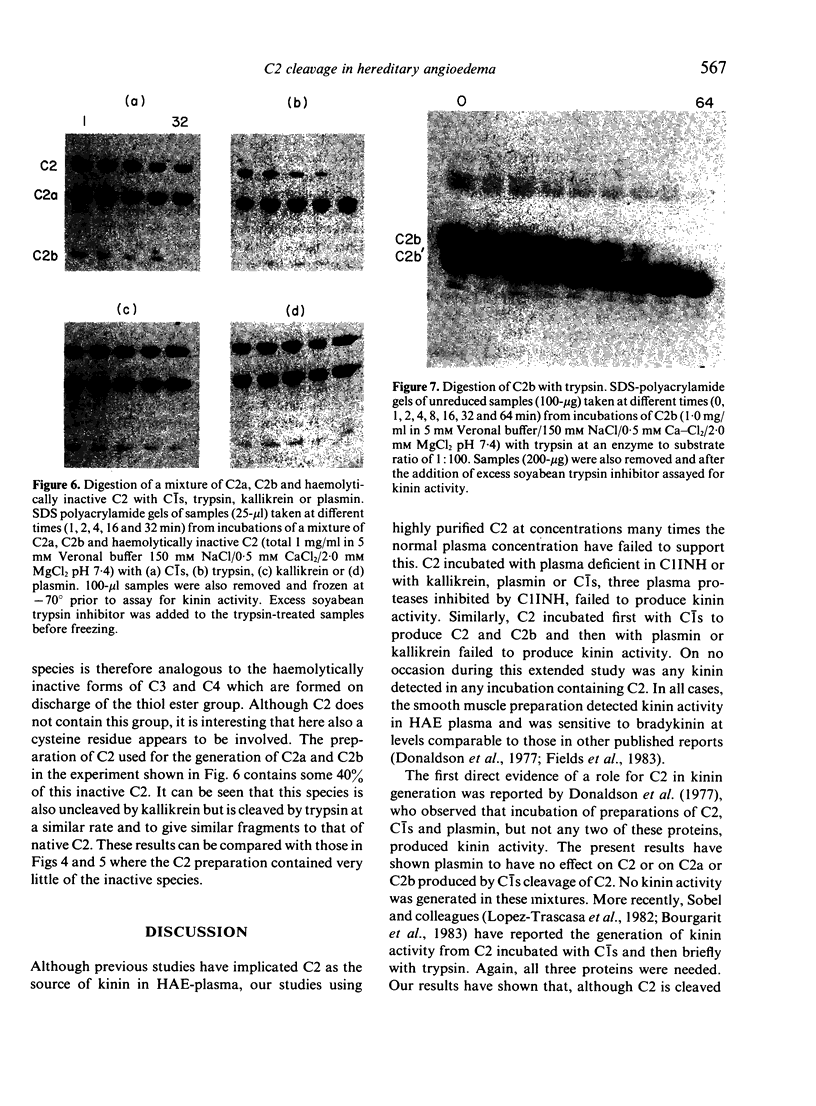
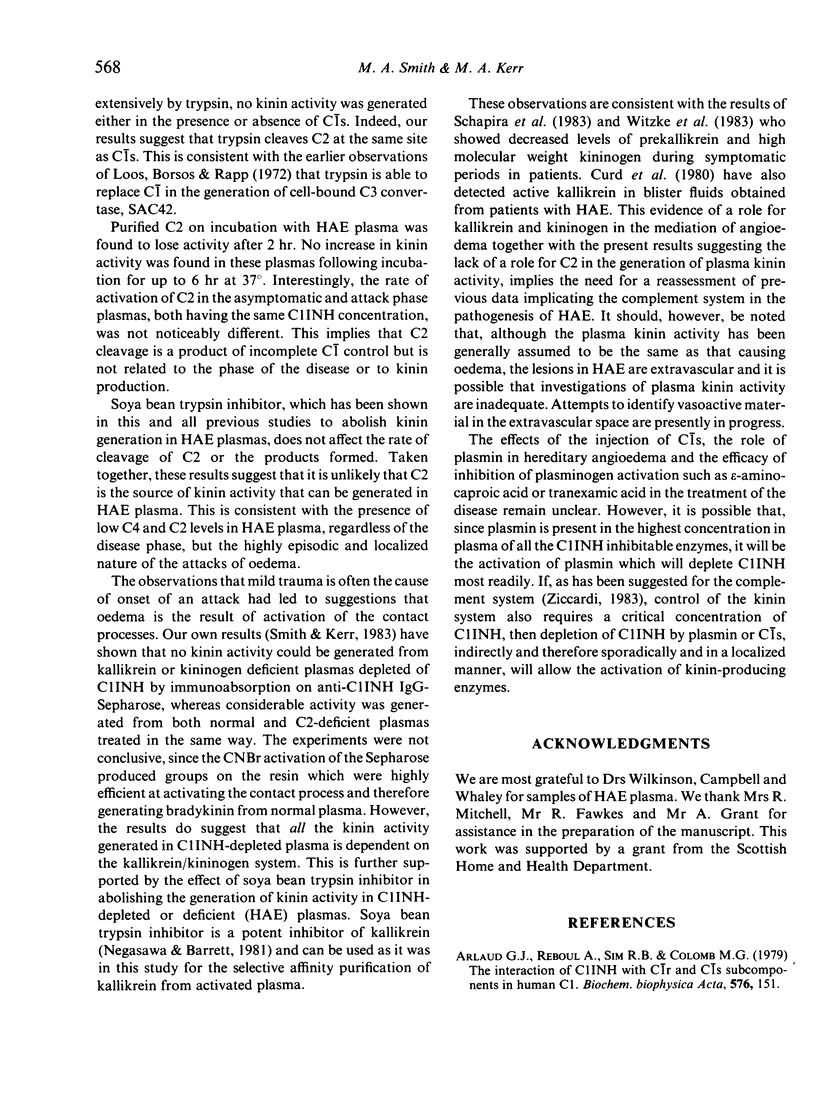

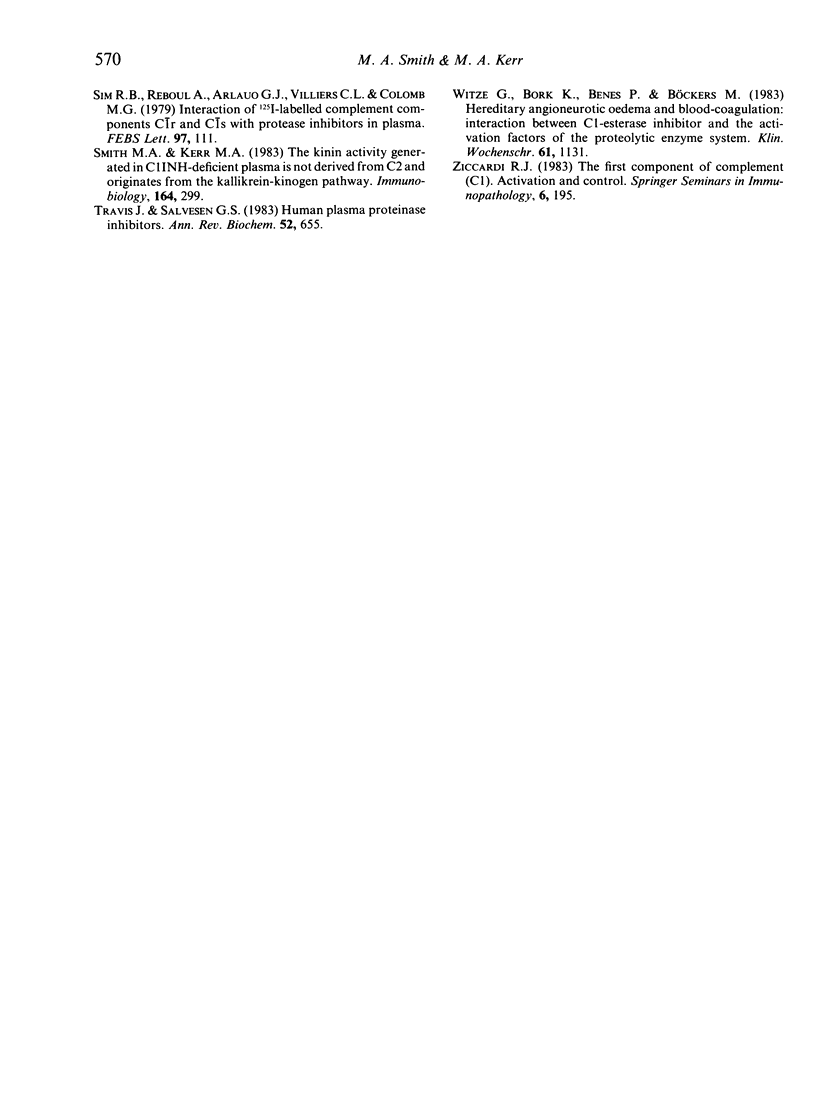
Images in this article
Selected References
These references are in PubMed. This may not be the complete list of references from this article.
- AUSTEN K. F., SHEFFER A. L. DETECTION OF HEREDITARY ANGIONEUROTIC EDEMA BY DEMONSTRATION OF A REDUCTION IN THE SECOND COMPONENT OF HUMAN COMPLEMENT. N Engl J Med. 1965 Apr 1;272:649–656. doi: 10.1056/NEJM196504012721301. [DOI] [PubMed] [Google Scholar]
- Arlaud G. J., Reboul A., Sim R. B., Colomb M. G. Interaction of C1-inhibitor with the C1r and C1s subcomponents in human C1. Biochim Biophys Acta. 1979 Jan 25;576(1):151–162. doi: 10.1016/0005-2795(79)90494-x. [DOI] [PubMed] [Google Scholar]
- Ballogh Z., Whaley K. Hereditary angio-oedema: its pathogenesis and management. Scott Med J. 1980 Jul;25(3):187–195. doi: 10.1177/003693308002500303. [DOI] [PubMed] [Google Scholar]
- Castellino F. J., Powell J. R. Human plasminogen. Methods Enzymol. 1981;80(Pt 100):365–378. doi: 10.1016/s0076-6879(81)80031-6. [DOI] [PubMed] [Google Scholar]
- Curd J. G., Prograis L. J., Jr, Cochrane C. G. Detection of active kallikrein in induced blister fluids of hereditary angioedema patients. J Exp Med. 1980 Sep 1;152(3):742–747. doi: 10.1084/jem.152.3.742. [DOI] [PMC free article] [PubMed] [Google Scholar]
- DONALDSON V. H., EVANS R. R. A BIOCHEMICAL ABNORMALITY IN HEREDIATRY ANGIONEUROTIC EDEMA: ABSENCE OF SERUM INHIBITOR OF C' 1-ESTERASE. Am J Med. 1963 Jul;35:37–44. doi: 10.1016/0002-9343(63)90162-1. [DOI] [PubMed] [Google Scholar]
- DONALDSON V. H., ROSEN F. S. ACTION OF COMPLEMENT IN HEREDITARY ANGIONEUROTIC EDEMA: THE ROLE OF C'1-ESTERASE. J Clin Invest. 1964 Nov;43:2204–2213. doi: 10.1172/JCI105094. [DOI] [PMC free article] [PubMed] [Google Scholar]
- Dodds A. W., Sim R. B., Porter R. R., Kerr M. A. Activation of the first component of human complement (C1) by antibody-antigen aggregates. Biochem J. 1978 Nov 1;175(2):383–390. doi: 10.1042/bj1750383. [DOI] [PMC free article] [PubMed] [Google Scholar]
- Donaldson V. H., Ratnoff O. D., Dias Da Silva W., Rosen F. S. Permeability-increasing activity in hereditary angioneurotic edema plasma. II. Mechanism of formation and partial characterization. J Clin Invest. 1969 Apr;48(4):642–653. doi: 10.1172/JCI106022. [DOI] [PMC free article] [PubMed] [Google Scholar]
- Donaldson V. H., Rosen F. S., Bing D. H. Role of the second component of complement (C2) and plasmin in kinin release in hereditary angioneurotic edema (H.A.N.E.) plasma. Trans Assoc Am Physicians. 1977;90:174–183. [PubMed] [Google Scholar]
- Fields T., Ghebrehiwet B., Kaplan A. P. Kinin formation in hereditary angioedema plasma: evidence against kinin derivation from C2 and in support of "spontaneous" formation of bradykinin. J Allergy Clin Immunol. 1983 Jul;72(1):54–60. doi: 10.1016/0091-6749(83)90052-0. [DOI] [PubMed] [Google Scholar]
- Forbes C. D., Pensky J., Ratnoff O. D. Inhibition of activated Hageman factor and activated plasma thromboplastin antecedent by purified serum C1 inactivator. J Lab Clin Med. 1970 Nov;76(5):809–815. [PubMed] [Google Scholar]
- Frank M. M., Gelfand J. A., Atkinson J. P. Hereditary angioedema: the clinical syndrome and its management. Ann Intern Med. 1976 May;84(5):580–593. doi: 10.7326/0003-4819-84-5-580. [DOI] [PubMed] [Google Scholar]
- Gigli I., Mason J. W., Colman R. W., Austen K. F. Interaction of plasma kallikrein with the C1 inhibitor. J Immunol. 1970 Mar;104(3):574–581. [PubMed] [Google Scholar]
- Jackson K. W., Esmon N., Tang J. Streptokinase and staphylokinase. Methods Enzymol. 1981;80(Pt 100):387–394. doi: 10.1016/s0076-6879(81)80033-x. [DOI] [PubMed] [Google Scholar]
- Kerr M. A., Gagnon J. The purification and properties of the second component of guinea-pig complement. Biochem J. 1982 Jul 1;205(1):59–67. doi: 10.1042/bj2050059. [DOI] [PMC free article] [PubMed] [Google Scholar]
- Kerr M. A. Limited proteolysis of complement components C2 and factor B. Structural analogy and limited sequence homology. Biochem J. 1979 Dec 1;183(3):615–622. doi: 10.1042/bj1830615. [DOI] [PMC free article] [PubMed] [Google Scholar]
- Kerr M. A., Parkes C. The effects of iodine and thiol-blocking reagents on complement component C2 and on the assembly of the classical-pathway C3 convertase. Biochem J. 1984 Apr 15;219(2):391–399. doi: 10.1042/bj2190391. [DOI] [PMC free article] [PubMed] [Google Scholar]
- Kerr M. A., Porter R. R. The purification and properties of the second component of human complement. Biochem J. 1978 Apr 1;171(1):99–107. doi: 10.1042/bj1710099. [DOI] [PMC free article] [PubMed] [Google Scholar]
- Kerr M. A. The human complement system: assembly of the classical pathway C3 convertase. Biochem J. 1980 Jul 1;189(1):173–181. doi: 10.1042/bj1890173. [DOI] [PMC free article] [PubMed] [Google Scholar]
- LANDERMAN N. S., WEBSTER M. E., BECKER E. L., RATCLIFFE H. E. Hereditary angioneurotic edema. II. Deficiency of inhibitor for serum globulin permeability factor and/or plasma kallikrein. J Allergy. 1962 Jul-Aug;33:330–341. doi: 10.1016/0021-8707(62)90032-1. [DOI] [PubMed] [Google Scholar]
- Laemmli U. K. Cleavage of structural proteins during the assembly of the head of bacteriophage T4. Nature. 1970 Aug 15;227(5259):680–685. doi: 10.1038/227680a0. [DOI] [PubMed] [Google Scholar]
- Loos M., Borsos T., Rapp H. J. Immune hemolysis and the functional properties of the second (C2) and fourth (C4) components of complement. IV. Formation of EAC42 by treatment of C2 with trypsin in the presence of EAC4. J Immunol. 1972 Sep;109(3):434–438. [PubMed] [Google Scholar]
- Nagase H., Barrett A. J. Human plasma kallikrein. A rapid purification method with high yield. Biochem J. 1981 Jan 1;193(1):187–192. doi: 10.1042/bj1930187. [DOI] [PMC free article] [PubMed] [Google Scholar]
- Parkes C., Gagnon J., Kerr M. A. The reaction of iodine and thiol-blocking reagents with human complement components C2 and factor B. Purification and N-terminal amino acid sequence of a peptide from C2a containing a free thiol group. Biochem J. 1983 Jul 1;213(1):201–209. doi: 10.1042/bj2130201. [DOI] [PMC free article] [PubMed] [Google Scholar]
- RATNOFF O. D., LEPOW I. H. Some properties of an esterase derived from preparations of the first component of complement. J Exp Med. 1957 Aug 1;106(2):327–343. doi: 10.1084/jem.106.2.327. [DOI] [PMC free article] [PubMed] [Google Scholar]
- Ratnoff O. D., Pensky J., Ogston D., Naff G. B. The inhibition of plasmin, plasma kallikrein, plasma permeability factor, and the C'1r subcomponent of the first component of complement by serum C'1 esterase inhibitor. J Exp Med. 1969 Feb 1;129(2):315–331. doi: 10.1084/jem.129.2.315. [DOI] [PMC free article] [PubMed] [Google Scholar]
- Schapira M., Silver L. D., Scott C. F., Schmaier A. H., Prograis L. J., Jr, Curd J. G., Colman R. W. Prekallikrein activation and high-molecular-weight kininogen consumption in hereditary angioedema. N Engl J Med. 1983 May 5;308(18):1050–1053. doi: 10.1056/NEJM198305053081802. [DOI] [PubMed] [Google Scholar]
- Schreiber A. D., Kaplan A. P., Austen K. F. Inhibition by C1INH of Hagemann factor fragment activation of coagulation, fibrinolysis, and kinin generation. J Clin Invest. 1973 Jun;52(6):1402–1409. doi: 10.1172/JCI107313. [DOI] [PMC free article] [PubMed] [Google Scholar]
- Sim R. B., Reboul A., Arlaud G. J., Villiers C. L., Colomb M. G. Interaction of 125I-labelled complement subcomponents C-1r and C-1s with protease inhibitors in plasma. FEBS Lett. 1979 Jan 1;97(1):111–115. doi: 10.1016/0014-5793(79)80063-0. [DOI] [PubMed] [Google Scholar]
- Sim R. B. The human complement system serine proteases C1r and C1s and their proenzymes. Methods Enzymol. 1981;80(Pt 100):26–42. doi: 10.1016/s0076-6879(81)80006-7. [DOI] [PubMed] [Google Scholar]
- Travis J., Salvesen G. S. Human plasma proteinase inhibitors. Annu Rev Biochem. 1983;52:655–709. doi: 10.1146/annurev.bi.52.070183.003255. [DOI] [PubMed] [Google Scholar]
- Witzke G., Bork K., Benes P., Böckers M. Hereditary angioneurotic oedema and blood-coagulation: interaction between C1-esterase-inhibitor and the activation factors of the proteolytic enzyme systems. Klin Wochenschr. 1983 Nov 15;61(22):1131–1135. doi: 10.1007/BF01530840. [DOI] [PubMed] [Google Scholar]





